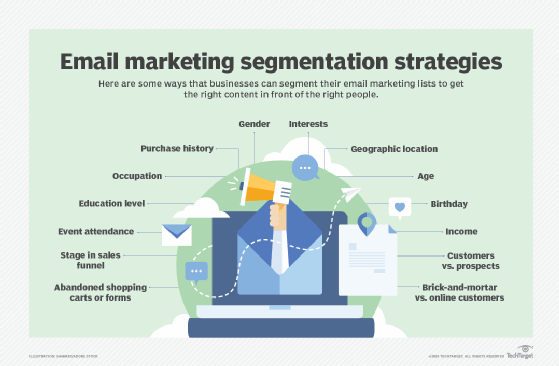
Eugenio Marongiu - Fotolia
9 strategies for email marketing segmentation
There are a number of strategies businesses can use to segment email marketing lists, including geographic location, purchase history, abandoned carts and forms, and gender.
While face-to-face contact and phone calls are still important forms of communication in business, email has quickly climbed the ladder.
Email is often the first line of communication in businesses, and ensuring that recipients open and read those emails is a primary goal for senders. Segmenting email marketing lists can help get the right information in front of the right people.
Email marketing segmentation is the practice of businesses taking their full database of email subscribers and dividing the contacts into smaller segments for a more targeted or personalized experience. Businesses divide subscribers by grouping recipients based on sets of similar criteria, such as demographic information, subscription source and purchase history. With these segments in place, marketing departments can use the lists to deliver more relevant content to individuals in those groups as opposed to sending a singular message to all.
Importance of email marketing segmentation
More than 246 billion emails are sent and received each day -- of those, 128 billion are for business purposes, according to research from Radicati Group Inc. With so many emails landing in customers' inboxes, email segmentation can be the difference between opening an email or deleting it.
Outside of being able to deliver personalized and relevant content to individual sets of subscribers, there are a number of other benefits business reap from deploying list segmentation for their email campaigns, including:
- higher open rate and more clicks;
- increase in email revenue; and
- increase in repeat customer business.
Email marketing segmentation strategies
To take advantage of email segmentation benefits, there are a number of strategies that businesses can use to collect customer data and divide their contact lists.

Select an email marketing platform
Many small businesses start off by building contact lists using their day-to-day email platform -- such as Microsoft Outlook or Gmail -- but an email marketing platform is necessary to manage multiple lists and send to larger groups.
Email marketing platforms can act as a database for all business contacts. The ability to collect data and use it for list segmentation gives companies the chance to send targeted emails, while focusing on increased deliverability rates and reporting on email marketing engagement.
Some email marketing platforms include MailChimp, Constant Contact, ActiveCampaign and HubSpot.
Use forms to collect contact data
Using website forms is the easiest way to collect demographic information about contacts. Some important information for list segmentation includes:
- company name
- organization type
- job title
- income
- age
- birthday
- number of people (including children) in household
- marital status
- geographic location
- education level
- gender
Teams can choose what fields to put on certain forms to capture information that is relevant to their business. The more information businesses have about prospects, the more personalized the messaging can be.
Send a welcome email
Many times, a prospect enters a database with limited information, and businesses don't know what list to put these people on. By sending a welcome email, marketing teams can use different links and content recommendations to drive that user toward information they might be interested in. By doing this, a user self-identifies what list they may fit into best. This email can also drive them toward a form to complete so businesses can capture information that was left out of the initial database entry and the customer can provide a better idea of what emails to send them.
Track customer entry point
Tracking when a visitor enters a website and what content they engage with is important for identifying relevant content and email campaigns that businesses can deliver to them. Having a visitor converter on a website landing page -- such as a giveaway or ad promoting a certain product line or service -- encourages visitors to become customers and enables businesses to know what information and content a user is interested in.
Businesses can track traffic, clicks and bounce rates on webpages that customers and prospects visit using a web analytics platform such as Google Analytics.
Armed with that information, marketers can include related content specific to customers' implied needs and interests in subsequent email marketing campaigns. For example, if a prospect engages with a top-of-funnel asset piece, businesses can segment users into a list of contacts who have downloaded that asset and the next emails can deliver content that helps progress them further down the sales funnel.
Segment prospects and customers
While reaching out to prospects is important for driving revenue growth, businesses should pay just as much attention to returning customers. Creating different email lists for both prospects and customers is a necessity. It is easier to sell to current customers, so developing targeted emails for this audience is a great way to increase retention and Customer lifetime value. Satisfied customers will often buy from a company again, but companies can also use this tactic to upsell or cross-sell products and services to already-engaged audiences.
Segment by engagement
Oftentimes, there are multiple marketing campaigns running at once within a company. Using email segmentation by engagement enables marketing teams to identify which workflow or campaign stream to place individuals.
For example, if the goal of a marketing campaign is to get a prospect to download a white paper, businesses can send a series of emails until that user engages with the content. Once they engage with the content, businesses can place that user into a new list or marketing campaign stream to deliver the next asset or offer. This not only progresses a user through the sales funnel but also continues to increase engagement by delivering the relevant content to each user at the right time.
Send emails based on shopping cart or form abandonment
This combined strategy can satisfy both B2B and B2C companies.
Approximately 68% of shopping carts are abandoned prior to purchase, according to a study by Baymard Institute. So having a cart abandonment program in place enables emails to reinvigorate the initial interest in purchasing that product, often with a discount offer.
For B2B companies, form abandoners are a reality. Perhaps the offer wasn't of interest to the visitor, but the ability to recover them with other offers is a similar strategy to those e-commerce companies looking to convert prospects.
Send out referral emails
Some of the best customers in a company's database are those who refer other businesses and prospects to the brand. Segmenting these types of contacts into their own list enables businesses to send out email campaigns soliciting referrals, or even their own published case study on the website. Keeping communication open and strong with this audience will build brand equity and revenue from referral sources.
Segment lists by geographic location
Companies that offer products and services nationwide -- or globally -- would benefit from segmenting lists based on where users in their database live. Promotional campaigns based on seasonal or regional knowledge enable businesses to customize their offers.
For example, a business that offers landscape equipment may be more likely to market new snowblowers to regions with snow as opposed to promoting that product line in warmer climates. Time-based email messages are also beneficial to getting into inboxes when it makes the most sense, by staggering sends at the optimum time in different time zones.






